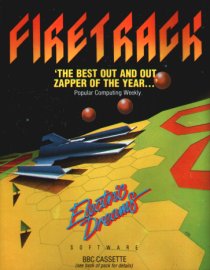
The Acorn Electron was a lower-cost alternative to the BBC Micro educational/home computer, also developed by Acorn Computers Ltd, to provide many of the features of that more expensive machine at a price more competitive with that of the ZX Spectrum. It had 32 kilobytes of RAM, and its ROM included BBC BASIC II together with the operating system. Announced in 1982 for a possible release the same year, it was eventually introduced on 25 August 1983 priced at £199.

The Color Graphics Adapter (CGA), originally also called the Color/Graphics Adapter or IBM Color/Graphics Monitor Adapter, introduced in 1981, was IBM's first color graphics card for the IBM PC and established a de facto computer display standard.

The PC Engine SuperGrafx, also known as simply the SuperGrafx, is a fourth-generation home video game console manufactured by NEC Home Electronics and released in Japan in 1989. It is the successor system to the PC Engine, released two years prior. Originally known as the PC Engine 2 during production stages, it was purported as a true 16-bit home console, featuring improved graphics and audio capabilities over its predecessor.

Alphanumeric Television Interface Controller (ANTIC) is an LSI ASIC dedicated to generating 2D computer graphics to be shown on a television screen or computer display. Under the direction of Jay Miner, the chip was designed in 1977–1978 by Joe Decuir, Francois Michel, and Steve Smith for the Atari 8-bit family of home computers first released in 1979 and was patented by Atari, Inc. in 1981. ANTIC is also used in the 1982 Atari 5200 video game console, which shares most of the same hardware as the 8-bit computers.

The Motorola 6845, or MC6845, is a display controller that was widely used in 8-bit computers during the 1980s. Originally intended for designs based on the Motorola 6800 CPU and given a related part number, it was more widely used alongside various other processors, and was most commonly found in machines based on the Zilog Z80 and MOS 6502.
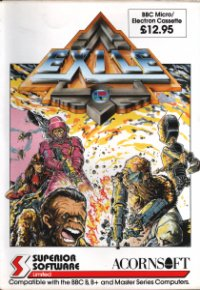
Exile is a single-player action-adventure video game originally published for the BBC Micro and Acorn Electron in 1988 by Superior Software and later ported to the Commodore 64, Amiga, CD32 and Atari ST, all published by Audiogenic. The game was designed and programmed by Peter Irvin and Jeremy Smith. It is often cited as one of the earliest examples of a Metroidvania game and featured "realistic gravity, inertia and object mass years before players understood the concept of a physics engine... an astounding level of AI, stealth-based gameplay, a logical ecosystem governing the world's creatures and a teleportation mechanic that feels startlingly like a predecessor to Portal".
A display list, also called a command list in Direct3D 12 and a command buffer in Vulkan, is a series of graphics commands so that they may be later run when the list is executed. Systems that make use of display list functionality are called retained mode systems, while systems that do not are as opposed to immediate mode systems. In OpenGL, display lists are useful to redraw the same geometry or apply a set of state changes multiple times. This benefit is also used with Direct3D 12's bundle command lists. In Direct3D 12 and Vulkan, display lists are regularly used for per-frame recording and execution.

Frak! is a scrolling platform video game programmed by Nick Pelling for the BBC Micro and Acorn Electron and published by his own Aardvark Software in 1984. It was ported to the Commodore 64 the following year by "The B Team". The BBC and Electron versions were included on the Superior Software compilation Play It Again Sam 4 in 1987 and re-issued in budget form by Alternative Software in 1989.
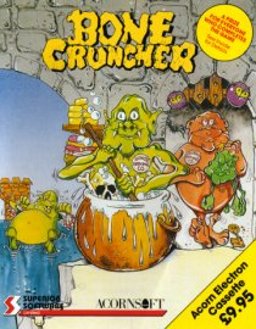
Bone Cruncher is a puzzle video game for the Acorn Electron, BBC Micro, and Commodore 64 first published by Superior Software in 1987. It uses the "rocks and diamonds" mechanics of Boulder Dash. An Amiga version was released in 1988.

The Machine Operating System (MOS) or OS is a discontinued computer operating system (OS) used in Acorn Computers' BBC computer range. It included support for four-channel sound, graphics, file system abstraction, and digital and analogue input/output (I/O) including a daisy-chained expansion bus. The system was single-tasking, monolithic and non-reentrant.
A raster interrupt is an interrupt signal in a legacy computer system which is used for display timing. It is usually, though not always, generated by a system's graphics chip as the scan lines of a frame are being readied to send to the monitor for display. The most basic implementation of a raster interrupt is the vertical blank interrupt.
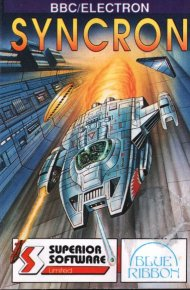
Syncron is a vertically scrolling shooter written by Gary Partis for the BBC Micro and Acorn Electron and published by Superior Software in 1987.

Stryker's Run is a video game designed by Chris Roberts and Philip Meller for the BBC Micro and BBC Master which was published by Superior Software in 1986. It was also later converted to the Acorn Electron. It is a 2D side-scrolling action game. It was well received, particularly for its graphics.

The British Broadcasting Corporation Microcomputer System, or BBC Micro, is a series of microcomputer designed and built by Acorn Computers Limited in the 1980s for the Computer Literacy Project of the BBC. Designed with an emphasis on education, it was notable for its ruggedness, expandability, and the quality of its operating system. The machine was the focus of a number of educational BBC TV programmes on computer literacy, starting with The Computer Programme in 1982, followed by Making the Most of the Micro, Computers in Control in 1983, and finally Micro Live in 1985.

Superman: The Man of Steel is a 1989 video game featuring the DC Comics character Superman. It was developed and published by UK software company Tynesoft under license from First Star Software.

Deathstar is multidirectional shooter for the Acorn Electron and BBC Micro developed by Peter Johnson and originally published in the UK by Superior Software in 1985. It is a clone of the arcade game Sinistar.
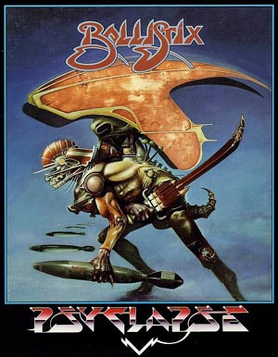
Ballistix is a video game created by Martin Edmondson for the Amiga and Atari ST and published by Psyclapse in 1989. It was also converted to a number of other home computers in the same year and the PC Engine/TurboGrafx-16 console in 1991. It is a fictional futuristic sport involving directing a puck to a goal by shooting small balls at it.
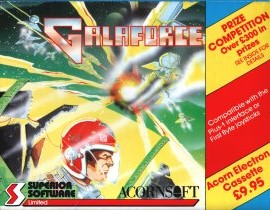
Galaforce is a fixed shooter video game for the BBC Micro and Acorn Electron, written by Kevin Edwards and published by Superior Software in 1986. It spawned a sequel, Galaforce 2 (1988), and later, Galaforce Worlds (2003).

Castle Quest is action-adventure game for the BBC Micro noted at the time of release as being the best game on the platform in its genre for its problem solving, colourful graphics and smooth scrolling.
